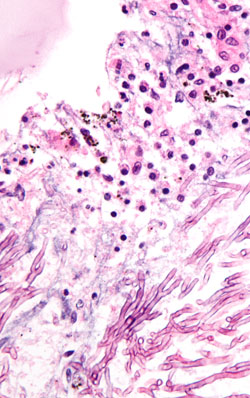
Aflatoxins belongs to an important group of mycotoxins (fungal toxins) that have received considerable attention due to their significance in animal and human health. These toxins were first isolated from ground nut meal (peanut meal) following an outbreak of liver disease among ducklings, turkeys, and pigs during 1960 in England. Later similar epidemics were also reported from other parts of the world including liver disease in ducklings in Kenya and hatchery reared trout in the United States . Investigations revealed that toxicity was associated with the fungus Aspergillus flavus, and the name “aflatoxin” (Aspergillus flavus toxins ) was accordingly assigned to the toxin. Further studies revealed that two more species of Aspergillus A.parasiticus and A.nomius are also known to produce these toxins.
These fungi are generally found in a variety of substrates in warmer parts of the world especially in humid tropical areas. As a common soil fungi they are responsible for decomposition of plant materials. It is generally found in contaminated vegetable food like corn, peanuts, cotton seed, copra, spices like pepper, clove, garlic, chilies etc., which are grown or stored in damp surroundings. Infection of these fungi as well as production and accumulation of aflatoxin is dependant up on external factors including weather conditions. High humidity favors the infection of Asperigillus species in pre harvest as well as in post harvest stages. On the other hand lower soil moisture and higher atmospheric temperature (which is generally found in draught affected areas) favors the spread of the air borne spores of theses toxic fungi. Although production of aflatoxin is generally restricted to food crops grown in warmer parts of the world, international trading of agricultural commodities from these production centers contribute its spread in regions where these crops are not grown.
Characteristics of aflatoxins
Aflatoxins are secondary metabolites of the fungi species Aspergillus flavus, A. parasiticus and A. nomius. They belong to a family of toxic, acetate-derived decaketides that arise biosynthetically through poly-hydroxy-anthraquinone intermediates. Approximately 20 related fungal metabolites are grouped under aflatoxins. They are classified into a number of subtypes and are named by letters and subscripts. The most important ones normally found in food are B1, B2, G1 and G2.
Aflatoxins are odorless, tasteless and colourless compounds thus, they are difficult to detect. They are chemically stable in foods and are resistant to degradation under normal cooking procedures. Elimination of aflatoxin is difficult, once it is produced in the food and hence pose major health problems.Detailed studies in various parts of the world confirm that the most important one the Aflatoxin B1, is the biosynthetic precursor of all the other aflatoxins.
It is usually associated with aflatoxin B2 and are usually produced by both species Aspergillus flavus and A.parasiticus. Aflatoxins G1 and G2 are formed only by A. parasiticus. In addition, aflatoxin M1 and M2 are formed as hydroxylated metabolites of aflatoxin B1 and B2 respectively. Aflatoxin M1 is secreted with the milk after feeding of aflatoxin B1 containing feed to lactating cows and other ruminants. Since it is thermo stable and is not destroyed by the pasteurizing process there is every chance for its spread in other dairy products such as curd, buttermilk, cheese and yoghurt.
Toxicity – aflatoxicosis
Disease caused by the consumption of aflatoxin contaminated food is called aflatoxicosis. In animals both acute and chronic toxicity occurs. In animals higher concentrations of these toxins lead to acute liver damage and death within two to three days. In lower concentrations symptoms varies from feed refusal to suppression of the immune system. Growth suppression and reproductive failure are also encountered.
Aflatoxins are metabolized in liver and consistently become the primary target resulting in liver cirrhosis. In human beings,high incidence of Hepatocellular carcimoma (HCC) has been reported from various parts of the world due to consumption of aflatoxin containing food. Aflatoxin exposures increases the risk of liver cancer in peoples who are infected with hepatitis B virus. It is also to be noted that a variety of adverse health problems associated with aflatoxin are also reported such as growth suppression in children.





